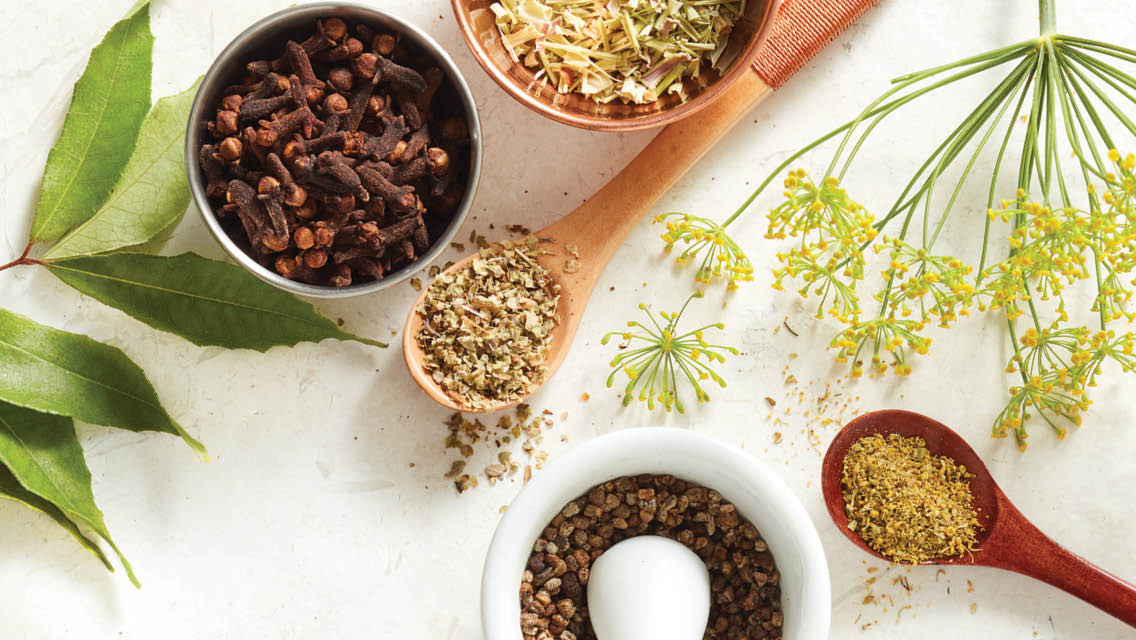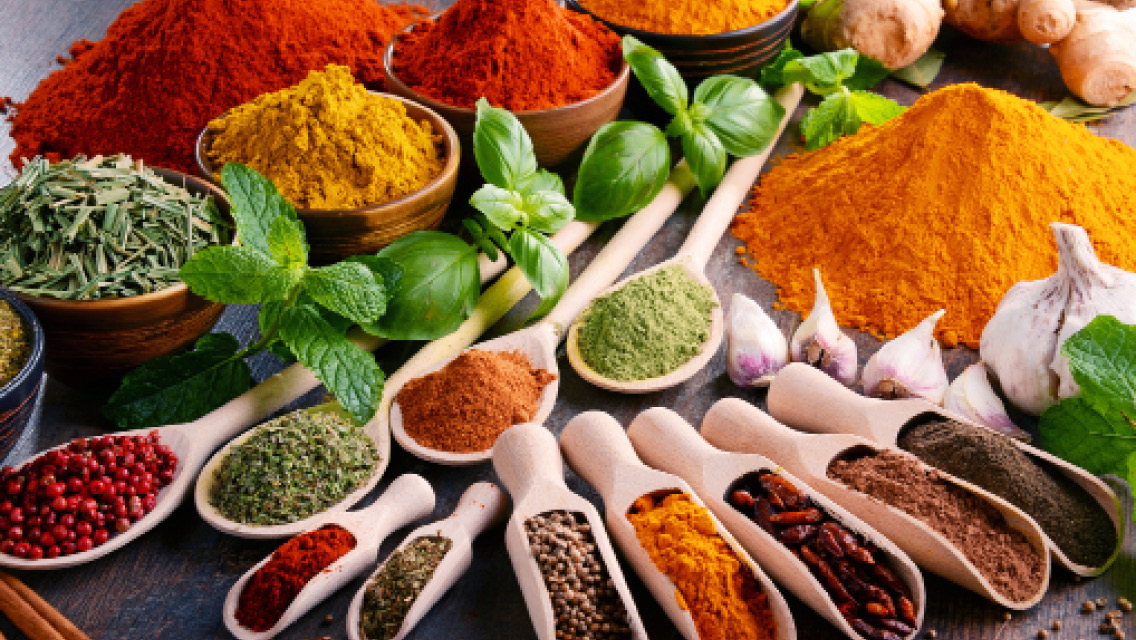Without herbs and spices, our dinners would be dull. They bring dishes to life, and they allow us to put our stamp on a recipe — to make it our own.
Many folks won’t hesitate to add a pinch of cinnamon or a smidge of fresh rosemary, but there are plenty of other seasonings to get to know. Adding a few of these underrated herbs and spices to your kitchen cabinet can open a world of possibilities.
Warming Spices
Amchur
Amchur (or amchoor) powder is an Indian spice derived from sun-dried unripe green mangoes. The tart, tangy powder adds a touch of brightness to a dish, the same way you might use a spritz of lemon or lime.
A staple in North Indian, Bengali, and other South Asian cuisines, amchur has a citrusy, subtly sweet flavor that pairs sublimely with anything savory. Undoubtedly, this is why it’s a key ingredient in chaat masala, a spice mix used to season various Indian snacks known as chaat.
Think of amchur as a daub of bright paint on a blank canvas — you can use it to bring a tangy touch to any number of simple snacks, including popcorn, nuts, and raw veggies. Is that hummus a bit boring? Sprinkle in some amchur. Use a pinch to liven up fruit salads, soups, stews, and curries. Beyond the layer of flavor it adds, amchur has a practical use in marinades: Its enzymes and acidity are great for softening up tough cuts of meat.
Cardamom
The pantry of virtually everyone in South Asia contains a jar of cardamom. In its native India, cooks use the seed pods to impart their sweet, citrusy eucalyptus flavor to rice dishes and curries; desserts, such as burfi (also spelled barfi); drinks, such as masala chai; and more.
Cardamom is also a common baking spice in Nordic countries, where it’s used for sweet breads and rolls, like Swedish kardemummabullar.
Cardamom comes in two varieties: black and green. Smoky, woodsy black cardamom is typically used in savory dishes, while more floral green cardamom works with sweet or savory flavors. Both varieties feature anti-inflammatory properties that may improve insulin sensitivity and high blood pressure.
Toss some cardamom pods into curries and stews, or add ground cardamom to marinades or healthy baked treats. It’s particularly delicious when paired with autumnal ingredients, such as pumpkins, figs, and apples. Or use cardamom to make masala chai (try our Chai Tea With Toasted Spices).
Clove
The warming notes of clove are a familiar flavor in gingerbread and pumpkin-spice blends. Cloves boast a bold aroma and flavor, similar to nutmeg but sweeter and richer, with a touch of warmth.
Across Asia, Africa, and the Middle East, cloves impart warmth to hearty stews, fragrant curries, and spicy marinades. In the West, the spice is a staple in baked treats, adding depth to pies, cakes, and cookies. Cloves also make a beautiful addition to hot drinks like masala chai and mulled cider or wine.
Rich in antioxidants, cloves have antibacterial and antifungal properties and may help kill cancer cells, thanks to eugenol, the aromatic compound that gives clove buds their signature flavor.
Cloves play well with other warming spices like allspice, cinnamon, ginger, and star anise. Because of the intensity of its flavor, you need only a few clove buds or a small pinch of ground cloves in your cooking or baking.
Using Ground Versus Whole Spices
Ground spices pack more potent flavor than whole spices. They’re ideal for baking, as well as for sauces, soups, stews, and marinades — anything with a smooth texture. When cooking on the stovetop, add ground spices to the pot briefly before adding liquid, so they have a chance to toast and release their essential oils.
Whole spices impart their flavor more slowly and are best for long-simmered recipes like stews and soups. For easy removal, tie them in a piece of cheesecloth before dropping them into the pot.
Tempering your whole spices — toasting or sautéing them before stirring them into a steaming pot of deliciousness — releases the aromatic oils and enhances their flavor, so they’ll have more impact on whatever you’re cooking.
Spices never truly go bad, but when their aromas begin to fade, you’ll want to replace them. Whole spices have an average shelf life of two to four years, and you can expect your ground spices to stay usable for two to three years.
Some recipes call for whole and ground spices, which will add layers of flavor to the dish. But there aren’t any hard-and-fast rules: If you prefer the more subtle flavor of whole spices in a stew, there’s no reason you shouldn’t use them. (Find our tips for sourcing high-quality spices at “6 Tips for Sourcing High-Quality, Fair-Trade Spices“.)
Aromatic Herbs
Curry Leaf
A crucial component of dal and many other dishes, curry leaves are a fresh herb picked from curry trees. They’re entirely different from curry powder, which is a ground blend of herbs and spices that varies by region. Both items can be used to make a curry, which is a blanket term for any number of spicy, saucy dishes in Southeast Asian cuisine.
While curry powder is used to flavor a whole dish, curry leaves are more of a background note. Their herbal, citrusy flavor becomes slightly nutty after cooking.
There’s not much that can’t be improved with a few curry leaves. Try them in tadka, a mix of herbs and spices that’s tempered in oil and used as a finishing touch on top of various Indian dishes. Stir curry leaves into homemade pickles, rice, or — of course — curries. Or sprinkle crushed, dried leaves over roasted vegetables or grain bowls.
Curry leaves, like so many of the other herbs and spices described here, are rich in antioxidants. A 2020 study looking at pharmaceutical qualities of curry-leaf extracts suggests they may have anticancer properties, among other benefits.
Dill
Grassy and citrusy, with anise-like notes, dill pairs well with tangy dairy: Sour cream, yogurt, and cream cheese are great bases for dill spreads and sauces.
The herb has Mediterranean origins, but it also makes appearances in Polish, Bulgarian, and Swedish cuisine.
Garnish salads, soups, and roasted vegetables with chopped dill, or use it to flavor fish or poached eggs. Mix it into yogurt for a quick dressing, or blend it into marinades to give them a bright, herby lift. (Try this bracing, citrusy salad topped with rich salmon and yogurt-dill sauce “Avocado-Citrus Salad With Poached Salmon and Yogurt-Dill Sauce“.)
Fennel Pollen
Native to the Mediterranean, fennel tastes of licorice. Fennel pollen, hand-harvested from the flowers of the fennel plant, has the same distinct flavor but with a zesty citrus note and elegant sweetness.
The spice tastes like the first glorious warm days of summer and has been dubbed “the spice of the angels.”
Fennel pollen is ideal for finishing sweet or savory dishes. Sprinkle a bit over roasted fish, chicken, or vegetables, or add a pinch to a smoothie bowl. If you’re lucky enough to have wild fennel growing nearby, it’s easy to forage.
Lemongrass
Lemongrass is wonderfully complex: lemony, herbaceous, floral, and spicy. Prevalent in Thai, Cambodian, Vietnamese, Laotian, Malaysian, and Indonesian recipes, it elevates dishes with its characteristic brightness.
The zesty, herbal flavors of fresh lemongrass make a stellar addition to stir-fries, marinades, dressings, and sauces. Dried lemongrass has more of a woodsy flavor, so it’s perfect for swirling into soups, curries, or anything simmered over gentle heat.
Dried or fresh, it can be brewed into a tea that offers various health benefits, such as lowering cholesterol, reducing inflammation, and helping to prevent tooth decay.
Marjoram
This Mediterranean herb tastes of citrus and pine. Fresh marjoram leaves elevate meat dishes, tomato sauces, roasted vegetables, and salad dressings.
Dried marjoram has a bolder flavor, which blends seamlessly into a simmering pot of soup or stew. It traditionally makes up part of the blend herbes de Provence, and it often appears in recipes for Thanksgiving stuffing or roasted chicken.
Long used in traditional medicine, marjoram delivers antioxidant, anti-inflammatory, and antimicrobial benefits. It may also aid in menstrual-cycle regulation, especially when consumed as a tea.
Using Fresh versus Dried Herbs
Fresh herbs are a treat, but dried herbs, with their longer shelf life, are easier for many home cooks to keep on hand. Dried herbs last one to three years; if they’ve lost their aroma, it’s time to replace them.
When dried, some herbs mellow out to the point that there’s not much flavor left. Tender herbs like basil, parsley, and dill, for instance, are better used fresh. Lightly bruising them before adding them to a dish will help release their aromatic compounds.
Some dried herbs deliver more concentrated flavor than their fresh counterparts. Typically, you can substitute one teaspoon of dried herbs for one tablespoon of fresh, but when in doubt, let your taste buds be your guide.





This Post Has 0 Comments